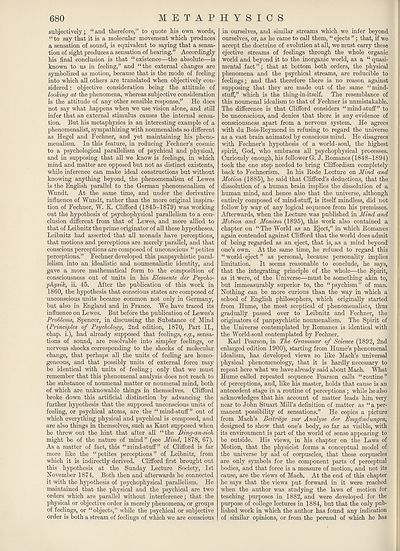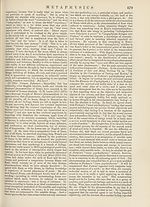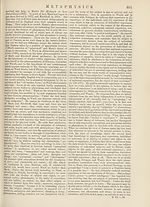New volumes of the Encyclopædia Britannica > Volume 30, K-MOR
(724) Page 680
Download files
Complete book:
Individual page:
Thumbnail gallery: Grid view | List view

680 M E T A P
subjectively; “and therefore,” to quote his own words,
“ to say that it is a molecular movement which produces
a sensation of sound, is equivalent to saying that a sensa¬
tion of sight produces a sensation of hearing.” Accordingly
his final conclusion is that “existence—the absolute—is
known to us in feeling,” and “the external changes are
symbolized as motion, because that is the mode of feeling
into which all others are translated when objectively con¬
sidered : objective consideration being the attitude of
looking at the phenomena, whereas subjective consideration
is the attitude of any other sensible response.” He does
not say what happens when we use vision alone, and still
infer that an external stimulus causes the internal sensa¬
tion. But his metaphysics is an interesting example of a
phenomenalist, sympathizing with noumenalists so different
as Hegel and Fechner, and yet maintaining his pheno¬
menalism. In this feature, in reducing Fechner’s cosmic
to a psychological parallelism of psychical and physical,
and in supposing that all we know is feelings, in which
mind and matter are opposed but not as distinct existents,
while inference can make ideal constructions but without
knowing anything beyond, the phenomenalism of Lewes
is the English parallel to the German phenomenalism of
Wundt. At the same time, and under the derivative
influence of Wundt, rather than the more original inspira¬
tion of Fechner, W. K. Clifford (1845-1879) was working
out the hypothesis of psychophysical parallelism to a con¬
clusion different from that of Lewes, and more allied to
that of Leibnitz the prime originator of all these hypotheses.
Leibnitz had asserted that all monads have perceptions,
that motions and perceptions are merely parallel, and that
conscious perceptions are composed of unconscious “ petites
perceptions.” Fechner developed this panpsychistic paral¬
lelism into an idealistic and noumenalistic identity, and
gave a more mathematical form to the composition of
consciousness out of units in his Elemente der Psycho-
])hysik, ii. 45. After the publication of this work in
1860, the hypothesis that conscious states are composed of
unconscious units became common not only in Germany,
but also in England and in France. We have traced its
influence on Lewes. But before the publication of Lewes’s
Problems, Spencer, in discussing the Substance of Mind
{Principles of Psychology, 2nd edition, 1870, Part II.,
chap, i.), had already supposed that feelings, e.g., sensa¬
tions of sound, are resolvable into simpler feelings, or
nervous shocks corresponding to the shocks of molecular
change, that perhaps all the units of feeling are homo¬
geneous, and that possibly units of external force may
be identical with units of feeling; only that we must
remember that this phenomenal analysis does not reach to
the substance of noumenal matter or noumenal mind, both
of which are unknowable things in themselves. Clifford
broke down this artificial distinction by advancing the
further hypothesis that the supposed unconscious units of
feeling, or psychical atoms, are the “mind-stuff” out of
which everything physical and psychical is composed, and
are also things in themselves, such as Kant supposed when
he threw out the hint that after all “the Ding-an-sich
might be of the nature of mind” (see Mind, 1878, 67).
As a matter of fact, this “mind-stuff” of Clifford is far
more like the “petites perceptions” of Leibnitz, from
which it is indirectly derived. Clifford first brought out
this hypothesis at the Sunday Lecture Society, 1st
November 1874. Both then and afterwards he connected
it with the hypothesis of psychophysical parallelism. He
maintained that the physical and the psychical are two
orders which are parallel without interference; that the
physical or objective order is merely phenomena, or groups
of feelings, or “objects,” while the psychical or subjective
order is both a stream of feelings of which we are conscious
H Y S I C S
in ourselves, and similar streams which we infer beyond
ourselves, or, as he came to call them, “ ejects ”; that, if we
accept the doctrine of evolution at all, we must carry these
eject!ve streams of feelings through the whole organic
world and beyond it to the inorganic world, as a “ quasi¬
mental fact ”; that at bottom both orders, the physical
phenomena and the psychical streams, are reducible to
feelings; and that therefore there is no reason against
supposing that they are made out of the same “mind-
stuff,” which is the thing-in-itself. The resemblance of
this noumenal idealism to that of Fechner is unmistakable.
The difference is that Clifford considers “mind-stuff” to
be unconscious, and denies that there is any evidence of
consciousness apart from a nervous system. He agrees
with du Bois-Beymond in refusing to regard the universe
as a vast brain animated by conscious mind. He disagrees
with Fechner’s hypothesis of a world-soul, the highest
spirit, God, who embraces all psychophysical processes.
Curiously enough, his follower G. J. Romanes (1848-1894)
took the one step needed to bring Cliffordism completely
back to Fechnerism. In his Rede Lecture on Mind and
Motion (1885), he said that Clifford’s deductions, that the
dissolution of a human brain implies the dissolution of a
human mind, and hence also that the universe, although
entirely composed of mind-stuff, is itself mindless, did not
follow by way of any logical sequence from his premisses.
Afterwards, when the Lecture was published in Mind and
Motion and Monism (1895), this work also contained a
chapter on “The World as an Eject,” in which Romanes
again contended against Clifford that the world does admit
of being regarded as an eject, that is, as a mind beyond
one’s own. At the same time, he refused to regard this
“ world-eject ” as personal, because personality implies
limitation. It seems reasonable to conclude, he says,
that the integrating principle of the whole—the Spirit,
as it were, of the Universe—must be something akin to,
but immeasurably superior to, the “psychism” of man.
Nothing can be more curious than the way in which a
school of English philosophers, which originally started
from Hume, the most sceptical of phenomenalists, thus
gradually passed over to Leibnitz and Fechner, the
originators of panpsychistic noumenalism. The Spirit of
the Universe contemplated by Romanes is identical with
the World-soul contemplated by Fechner.
Karl Pearson, in The Grammar of Science (1892, 2nd
enlarged edition 1900), starting from Hume’s phenomenal
idealism, has developed views so like Mach’s universal
physical phenomenology, that it is hardly necessary to
repeat here what we have already said about Mach. What
Hume called repeated sequence Pearson calls “routine”
of perceptions, and, like his master, holds that cause is an
antecedent stage in a routine of perceptions ; while he also
acknowledges that his account of matter leads him very
near to John Stuart Mill’s definition of matter as “a per¬
manent possibility of sensations.” He copies a picture
from Mach’s Beitrdge zur Analyse der Empfindungen,
designed to show that one’s body, so far as visible, with
its environment is part of the world of sense appearing to
be outside. His views, in his chapter on the Laws of
Motion, that the physicist forms a conceptual model of
the universe by aid of corpuscles, that these corpuscles
are only symbols for the component parts of perceptual
bodies, and that force is a measure of motion, and not its
cause, are the views of Mach. At the end of this chapter
he says that the views put forward in it were reached
when the author was studying the laws of motion for
teaching purposes in 1882, and were developed for the
purpose of college lectures in 1884, but that the only pub¬
lished work in which the author has found any indication
of similar opinions, or from the perusal of which he has
subjectively; “and therefore,” to quote his own words,
“ to say that it is a molecular movement which produces
a sensation of sound, is equivalent to saying that a sensa¬
tion of sight produces a sensation of hearing.” Accordingly
his final conclusion is that “existence—the absolute—is
known to us in feeling,” and “the external changes are
symbolized as motion, because that is the mode of feeling
into which all others are translated when objectively con¬
sidered : objective consideration being the attitude of
looking at the phenomena, whereas subjective consideration
is the attitude of any other sensible response.” He does
not say what happens when we use vision alone, and still
infer that an external stimulus causes the internal sensa¬
tion. But his metaphysics is an interesting example of a
phenomenalist, sympathizing with noumenalists so different
as Hegel and Fechner, and yet maintaining his pheno¬
menalism. In this feature, in reducing Fechner’s cosmic
to a psychological parallelism of psychical and physical,
and in supposing that all we know is feelings, in which
mind and matter are opposed but not as distinct existents,
while inference can make ideal constructions but without
knowing anything beyond, the phenomenalism of Lewes
is the English parallel to the German phenomenalism of
Wundt. At the same time, and under the derivative
influence of Wundt, rather than the more original inspira¬
tion of Fechner, W. K. Clifford (1845-1879) was working
out the hypothesis of psychophysical parallelism to a con¬
clusion different from that of Lewes, and more allied to
that of Leibnitz the prime originator of all these hypotheses.
Leibnitz had asserted that all monads have perceptions,
that motions and perceptions are merely parallel, and that
conscious perceptions are composed of unconscious “ petites
perceptions.” Fechner developed this panpsychistic paral¬
lelism into an idealistic and noumenalistic identity, and
gave a more mathematical form to the composition of
consciousness out of units in his Elemente der Psycho-
])hysik, ii. 45. After the publication of this work in
1860, the hypothesis that conscious states are composed of
unconscious units became common not only in Germany,
but also in England and in France. We have traced its
influence on Lewes. But before the publication of Lewes’s
Problems, Spencer, in discussing the Substance of Mind
{Principles of Psychology, 2nd edition, 1870, Part II.,
chap, i.), had already supposed that feelings, e.g., sensa¬
tions of sound, are resolvable into simpler feelings, or
nervous shocks corresponding to the shocks of molecular
change, that perhaps all the units of feeling are homo¬
geneous, and that possibly units of external force may
be identical with units of feeling; only that we must
remember that this phenomenal analysis does not reach to
the substance of noumenal matter or noumenal mind, both
of which are unknowable things in themselves. Clifford
broke down this artificial distinction by advancing the
further hypothesis that the supposed unconscious units of
feeling, or psychical atoms, are the “mind-stuff” out of
which everything physical and psychical is composed, and
are also things in themselves, such as Kant supposed when
he threw out the hint that after all “the Ding-an-sich
might be of the nature of mind” (see Mind, 1878, 67).
As a matter of fact, this “mind-stuff” of Clifford is far
more like the “petites perceptions” of Leibnitz, from
which it is indirectly derived. Clifford first brought out
this hypothesis at the Sunday Lecture Society, 1st
November 1874. Both then and afterwards he connected
it with the hypothesis of psychophysical parallelism. He
maintained that the physical and the psychical are two
orders which are parallel without interference; that the
physical or objective order is merely phenomena, or groups
of feelings, or “objects,” while the psychical or subjective
order is both a stream of feelings of which we are conscious
H Y S I C S
in ourselves, and similar streams which we infer beyond
ourselves, or, as he came to call them, “ ejects ”; that, if we
accept the doctrine of evolution at all, we must carry these
eject!ve streams of feelings through the whole organic
world and beyond it to the inorganic world, as a “ quasi¬
mental fact ”; that at bottom both orders, the physical
phenomena and the psychical streams, are reducible to
feelings; and that therefore there is no reason against
supposing that they are made out of the same “mind-
stuff,” which is the thing-in-itself. The resemblance of
this noumenal idealism to that of Fechner is unmistakable.
The difference is that Clifford considers “mind-stuff” to
be unconscious, and denies that there is any evidence of
consciousness apart from a nervous system. He agrees
with du Bois-Beymond in refusing to regard the universe
as a vast brain animated by conscious mind. He disagrees
with Fechner’s hypothesis of a world-soul, the highest
spirit, God, who embraces all psychophysical processes.
Curiously enough, his follower G. J. Romanes (1848-1894)
took the one step needed to bring Cliffordism completely
back to Fechnerism. In his Rede Lecture on Mind and
Motion (1885), he said that Clifford’s deductions, that the
dissolution of a human brain implies the dissolution of a
human mind, and hence also that the universe, although
entirely composed of mind-stuff, is itself mindless, did not
follow by way of any logical sequence from his premisses.
Afterwards, when the Lecture was published in Mind and
Motion and Monism (1895), this work also contained a
chapter on “The World as an Eject,” in which Romanes
again contended against Clifford that the world does admit
of being regarded as an eject, that is, as a mind beyond
one’s own. At the same time, he refused to regard this
“ world-eject ” as personal, because personality implies
limitation. It seems reasonable to conclude, he says,
that the integrating principle of the whole—the Spirit,
as it were, of the Universe—must be something akin to,
but immeasurably superior to, the “psychism” of man.
Nothing can be more curious than the way in which a
school of English philosophers, which originally started
from Hume, the most sceptical of phenomenalists, thus
gradually passed over to Leibnitz and Fechner, the
originators of panpsychistic noumenalism. The Spirit of
the Universe contemplated by Romanes is identical with
the World-soul contemplated by Fechner.
Karl Pearson, in The Grammar of Science (1892, 2nd
enlarged edition 1900), starting from Hume’s phenomenal
idealism, has developed views so like Mach’s universal
physical phenomenology, that it is hardly necessary to
repeat here what we have already said about Mach. What
Hume called repeated sequence Pearson calls “routine”
of perceptions, and, like his master, holds that cause is an
antecedent stage in a routine of perceptions ; while he also
acknowledges that his account of matter leads him very
near to John Stuart Mill’s definition of matter as “a per¬
manent possibility of sensations.” He copies a picture
from Mach’s Beitrdge zur Analyse der Empfindungen,
designed to show that one’s body, so far as visible, with
its environment is part of the world of sense appearing to
be outside. His views, in his chapter on the Laws of
Motion, that the physicist forms a conceptual model of
the universe by aid of corpuscles, that these corpuscles
are only symbols for the component parts of perceptual
bodies, and that force is a measure of motion, and not its
cause, are the views of Mach. At the end of this chapter
he says that the views put forward in it were reached
when the author was studying the laws of motion for
teaching purposes in 1882, and were developed for the
purpose of college lectures in 1884, but that the only pub¬
lished work in which the author has found any indication
of similar opinions, or from the perusal of which he has
Set display mode to:
![]() Universal Viewer |
Universal Viewer | ![]() Mirador |
Large image | Transcription
Mirador |
Large image | Transcription
Images and transcriptions on this page, including medium image downloads, may be used under the Creative Commons Attribution 4.0 International Licence unless otherwise stated. ![]()
| Encyclopaedia Britannica > New volumes of the Encyclopædia Britannica > Volume 30, K-MOR > (724) Page 680 |
|---|
| Permanent URL | https://digital.nls.uk/193576913 |
|---|
| Attribution and copyright: |
|
|---|---|
| Shelfmark | EB.18 |
|---|---|
| Description | Ten editions of 'Encyclopaedia Britannica', issued from 1768-1903, in 231 volumes. Originally issued in 100 weekly parts (3 volumes) between 1768 and 1771 by publishers: Colin Macfarquhar and Andrew Bell (Edinburgh); editor: William Smellie: engraver: Andrew Bell. Expanded editions in the 19th century featured more volumes and contributions from leading experts in their fields. Managed and published in Edinburgh up to the 9th edition (25 volumes, from 1875-1889); the 10th edition (1902-1903) re-issued the 9th edition, with 11 supplementary volumes. |
|---|---|
| Additional NLS resources: |
|

